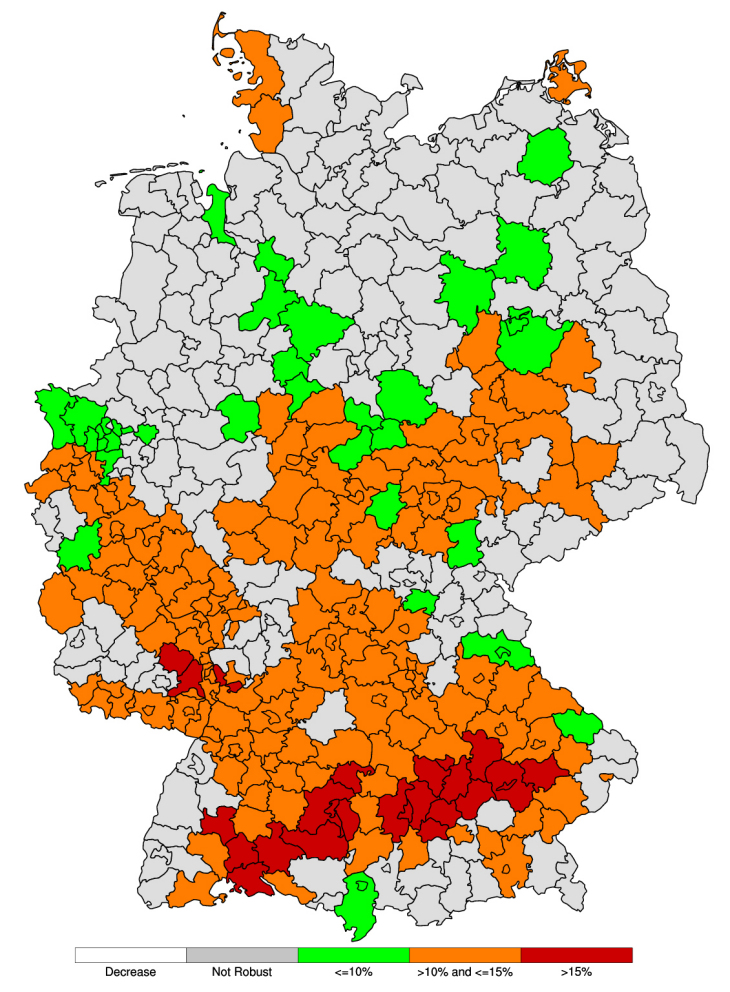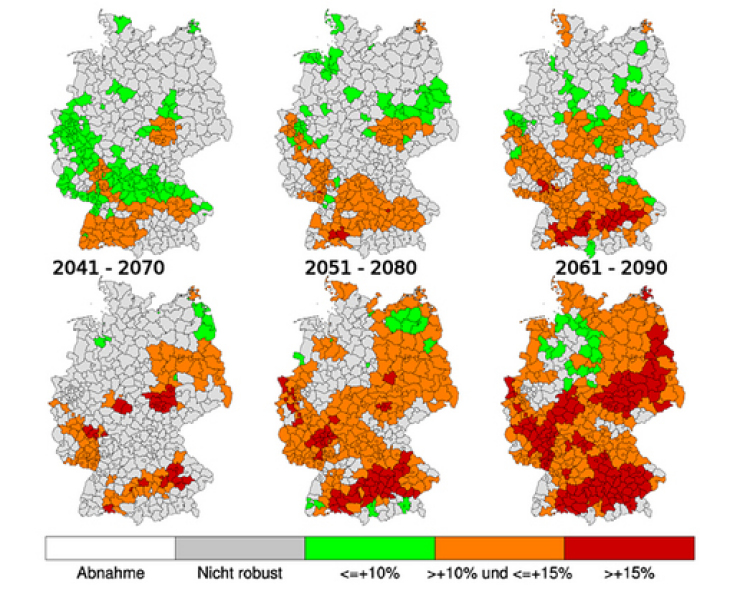GERICS Climate Signal Maps regional
In order to adapt the climate change, reliable information on future expected climatic changes is required. Possible future climate developments can be calculated based on scenarios and with the help of numeric climate models. These developments differ depending on the underlying assumptions on socio-economic scenarios and on future concentration of greenhouse gases and aerosols in the atmosphere.

Climate models are calculated on a spatial grid. Processes must therefore be parameterised on scales below the directly dissolvable model scales. In addition, not all processes relevant to the atmosphere, weather and climate are fully understood. These two reasons lead to the fact that models deviate from reality and that variations exist between the models. This again leads to varying simulation results for the different models. Furthermore, processes in the atmosphere are often non-linear. For the model calculations, however, the initial condition of a model atmosphere is specified. This is how slight changes in the initial conditions can lead to deviations in temporal climate development.
In order to capture various future climate development possibilities in projections, ensemble simulations are therefore used with different models for different scenarios. These span a wide range of possible climate changes. It is, however, not always directly evident from the range of possible climate changes whether robust information can be derived from the data.
The two following images illustrate this problem. They show the projected annual average temperature change range (fig. above) and the winter precipitation change range (fig. below) as an example for the Elbe catchment area.
![<strong>Above:</strong> Projected changes in annual average temperature ([K], moving thirty-year average relative to the period of 1971 to 2000) for the Elbe catchment area calculated from the EURO-CORDEX ensemble for RCP4.5 (solid lines) and RCP8.5 (dotted lines).
<strong>Below:</strong> Projected changes in winter precipitation ([%], moving thirty-year average relative to the period of 1971 to 2000) for the Elbe catchment area calculated from the EURO-CORDEX ensemble for RCP4.5 (solid lines) and RCP8.5 (dotted lines).
(Illustration: GERICS/HZG) Klimasignalkarten projizierte Aenderungen](/imperia/md/images/csc/images/test/fittosize__730_0_2de8b48979cc17afc065a12581ccdb3b_klimasignalkarten_projizierte_aenderungen.jpg)
Above: Projected changes in annual average temperature ([K], moving thirty-year average relative to the period of 1971 to 2000) for the Elbe catchment area calculated from the EURO-CORDEX ensemble for RCP4.5 (solid lines) and RCP8.5 (dotted lines).
Below: Projected changes in winter precipitation ([%], moving thirty-year average relative to the period of 1971 to 2000) for the Elbe catchment area calculated from the EURO-CORDEX ensemble for RCP4.5 (solid lines) and RCP8.5 (dotted lines).
(Illustration: GERICS/HZG)
The database is formed by an ensemble of regional climate change simulations based on Representative Concentration Pathways (RCP) * RCP4.5 and RCP8.5.
*The RCP scenarios determine certain greenhouse gas concentration scenarios. Initial points for each of these scenarios are thereby different greenhouse gas concentrations and thus different radiative forcing’s. RCP8.5 represents, for example, a radiative forcing of 8.5 W/m2 in the year 2100 as opposed to 1850.
The simulations were calculated and provided by the internationa EURO¬CORDEX initiative.
While temperature development for the near future already shows a clear trend toward increased temperatures, the development of winter precipitation is less clear. Only beginning in the middle of the 21st century, especially for the RCP8.5 simulations, is there a clearly visible increase of winter precipitation in simulation results.
To evaluate the robustness of the projected changes in climate simulation ensembles according to provided criteria and to make the results of such evaluations quickly comprehensible and spatially visible, the Climate Service Center Germany (GERICS/HZG) has developed the climate signal map method (Pfeifer et al., 2015). "Robust" is thereby defined as the agreement of simulations toward the projected changes as well as with the portion of the simulations that project statistically significant changes. Climate signal maps, however, do not show all available information in the projection ensemble, but rather condense the information. They are thus comprehensible for non-climate experts as well.
Climate signal maps can be represented based on the models' grid points or on regions selected by the user. In addition, only one direction of change is always examined, either the increase or decrease.

Climate signal maps for the increase of average winter precipitation for 2041-2070, 2051-2080, 2061-2090, in each case relative to 1971-2000. Green: Increase in the median <10%. Orange: Increase in the median between +10% and +15%. Red: : Increase in the median >15. Data are from EURO-CORDEX simulations based on RCP4.5 (above) and RCP8.5 (below). (Illustration: Pfeifer et al., 2015/GERICS/HZG)
The figure shows climate signal maps for the percentage increase of winter precipitation based on the EURO-CORDEX simulations for RCP4.5 (above) and RCP8.5 (below) for three different periods (2041-2070, 2051-2080, 2061-2090). The reference period was set for the years 1971 to 2000. Robust increases are projected in the areas marked in green/orange/red.
The three colour stages represent different threshold values. They are set based on the increased median of < 10% / 10% to 15% / >15%. For the regions marked in grey, no robust increased winter precipitation can be derived from the ensemble. Regions marked in white, those areas in which the simulation ensemble would project a decrease in the median winter precipitation, did not arise in the computations.
The maps also show that the projected winter precipitation increases more heavily under RCP8.5 conditions than under RCP4.5 conditions. For the periods between 2051-2080 and 2061-2090, RCP8.5 clearly shows more regions in which a robust signal can be derived, while for RCP4.5, no robust increase in winter precipitation can be derived for all three examined time periods in many regions, particularly in northern and eastern Germany.
Examples for different thematic Climate Signal Maps
